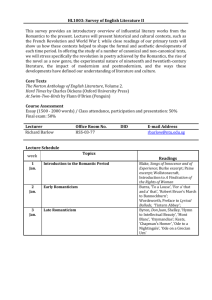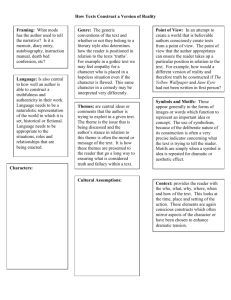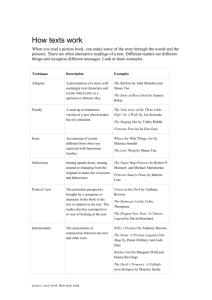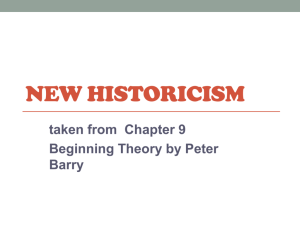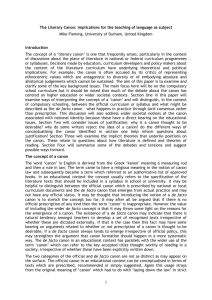Introduction to Contemporary Critical Theory or
advertisement
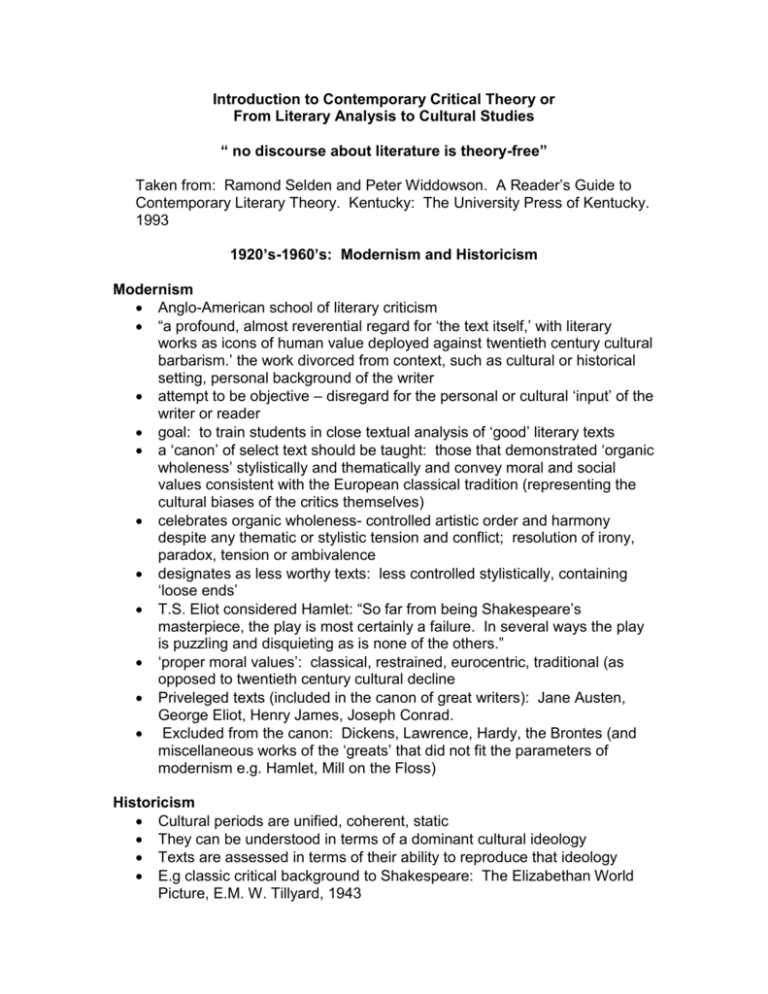
Introduction to Contemporary Critical Theory or From Literary Analysis to Cultural Studies “ no discourse about literature is theory-free” Taken from: Ramond Selden and Peter Widdowson. A Reader’s Guide to Contemporary Literary Theory. Kentucky: The University Press of Kentucky. 1993 1920’s-1960’s: Modernism and Historicism Modernism Anglo-American school of literary criticism “a profound, almost reverential regard for ‘the text itself,’ with literary works as icons of human value deployed against twentieth century cultural barbarism.’ the work divorced from context, such as cultural or historical setting, personal background of the writer attempt to be objective – disregard for the personal or cultural ‘input’ of the writer or reader goal: to train students in close textual analysis of ‘good’ literary texts a ‘canon’ of select text should be taught: those that demonstrated ‘organic wholeness’ stylistically and thematically and convey moral and social values consistent with the European classical tradition (representing the cultural biases of the critics themselves) celebrates organic wholeness- controlled artistic order and harmony despite any thematic or stylistic tension and conflict; resolution of irony, paradox, tension or ambivalence designates as less worthy texts: less controlled stylistically, containing ‘loose ends’ T.S. Eliot considered Hamlet: “So far from being Shakespeare’s masterpiece, the play is most certainly a failure. In several ways the play is puzzling and disquieting as is none of the others.” ‘proper moral values’: classical, restrained, eurocentric, traditional (as opposed to twentieth century cultural decline Priveleged texts (included in the canon of great writers): Jane Austen, George Eliot, Henry James, Joseph Conrad. Excluded from the canon: Dickens, Lawrence, Hardy, the Brontes (and miscellaneous works of the ‘greats’ that did not fit the parameters of modernism e.g. Hamlet, Mill on the Floss) Historicism Cultural periods are unified, coherent, static They can be understood in terms of a dominant cultural ideology Texts are assessed in terms of their ability to reproduce that ideology E.g classic critical background to Shakespeare: The Elizabethan World Picture, E.M. W. Tillyard, 1943 1970’s-1980’s: Psycholanalysis , Marxism, Structuralism Psychoanalytic theories Freud and Jung stream of consciousness Marxism class analysis, power Structuralism focus on the language of texts signals of the writer’s intention communicated through the use of language deconstruction, signs, tropes French linguistic critics dominate: Saussure 1980’s-present: Postmodernism Reader Response A literary work does not pop into the world as a finished and neatly parceled bundle of meaning; rather meaning depends on the historical situation of the interpreter Gender Studies Feminism Revisits text to reinterpret absent or present female characters Revisits texts written by women New Historicism Historical periods are not unified entities There is no single history, only discontinuous and contradictory histories The idea of a uniform and harmonious culture is a myth Culture is never static; on the contrary it is always in the process of change. At any given period, residual, dominant and emergent aspects of culture may exist simultaneously- causes the reader to look at marginalized and subversive aspects of the text – indications of cultural change These changing aspects of culture are generally understood in terms of power relations All interpretations of past literature arise from a dialogue between past and present Our attempts to understand a work will depend on the questions our own cultural environment allows us to raise Poststructuralism Deconstruction Language cannot be studied in isolation, is part of a social context Discourse – the social context of language- is often understood in terms of power(Foucault)- causes the critic or reader to look at who is privileged in the text and who is not, who speaks and does not speak Postmodernism Describes both artistic expression and critical theory – celebrates similar values and style Expresses skepticism towards previous certainties in personal intellectual and political life believes that the grand “narratives” of human progress and liberation, rooted in Enlightenment thought, have lost credibility dismisses the tradition of perceived hierarchy between high and popular culture intermingles genres and media, breaks down boundaries between different forms of artistic expression and discourse rejects the elitism, sophisticated formal experimentation and tragic sense of alienation found in modernist writers celebrates open, discontinuous, indeterminate structures expresses profound sense of uncertainty: neither the world nor the self any longer possess unity, coherence, meaning is not necessarily depressing, often playful, self-reflexive and selfparodying fiction raises questions rather than supplying answers Danziger’s approach to literature trained as an undergraduate in modernism, values close analysis of the text, rejects constraints of the canon of the formal criteria for “good literature” and for evaluating “good literature” trained as a graduate in postmodernism – values social and cultural orientation of contemporary criticism, issues of gender, power, questions raised by the text, reader responses to the text expects students to: read closely, use the text to support interpretation, stay open-minded, recognize and be conscious of the influence of their own cultural perspectives as readers Key Terms in Contemporary Critical Theory Canon Carnival Closed/open texts Codes Allegory A symbolic narrative in which the major features of the movement of the narrative all refer symbolically to some action or situation Appropriation The process by which one sector in society takes over the aspects of another – language,forms of writing, film, theater – could be imperial appropriation of the indigenous culture, could be postcolonial appropriation of the imperial culture Colonialism Commodification Cultural materialism Deconstruction Differences Discourse Existentialism freud Feminism Hegemony Hybridity The space in which cultural meanings and identities always contain the traces of other meanings and identities Hermeneutics Icons Imperialism Inclusion/exclusion Intention Jung Location/dislocation Magic realism Marginality/marginalization marxism Modernism Nativism The return to a pre-colonial or native culture or language naturalism New criticism New historicism orientalism other Postcolonialism Postmodernism poststructuralism power privilege Reader response realism Resistance romanticism Semiotics Signs/signification Space and time Stream of consciousness text trope Key People Benjamin, Walter Said, Bhaktin Spivak Williams Foucault Greenblatt
